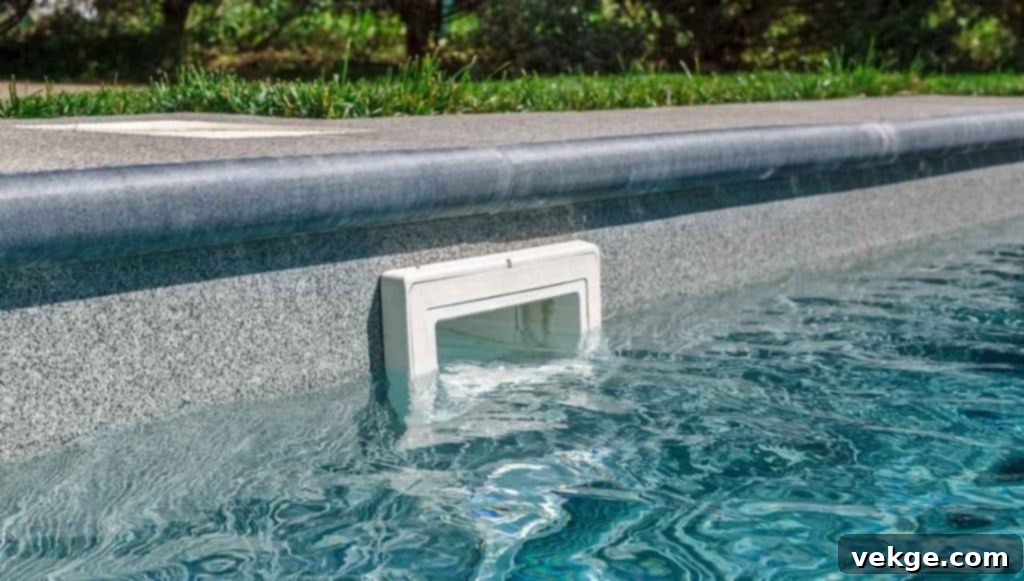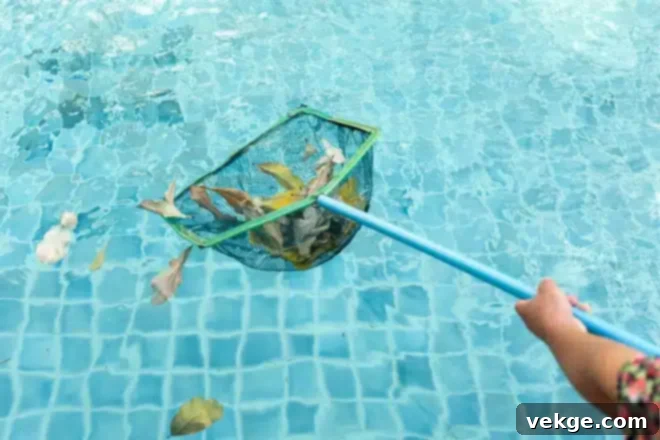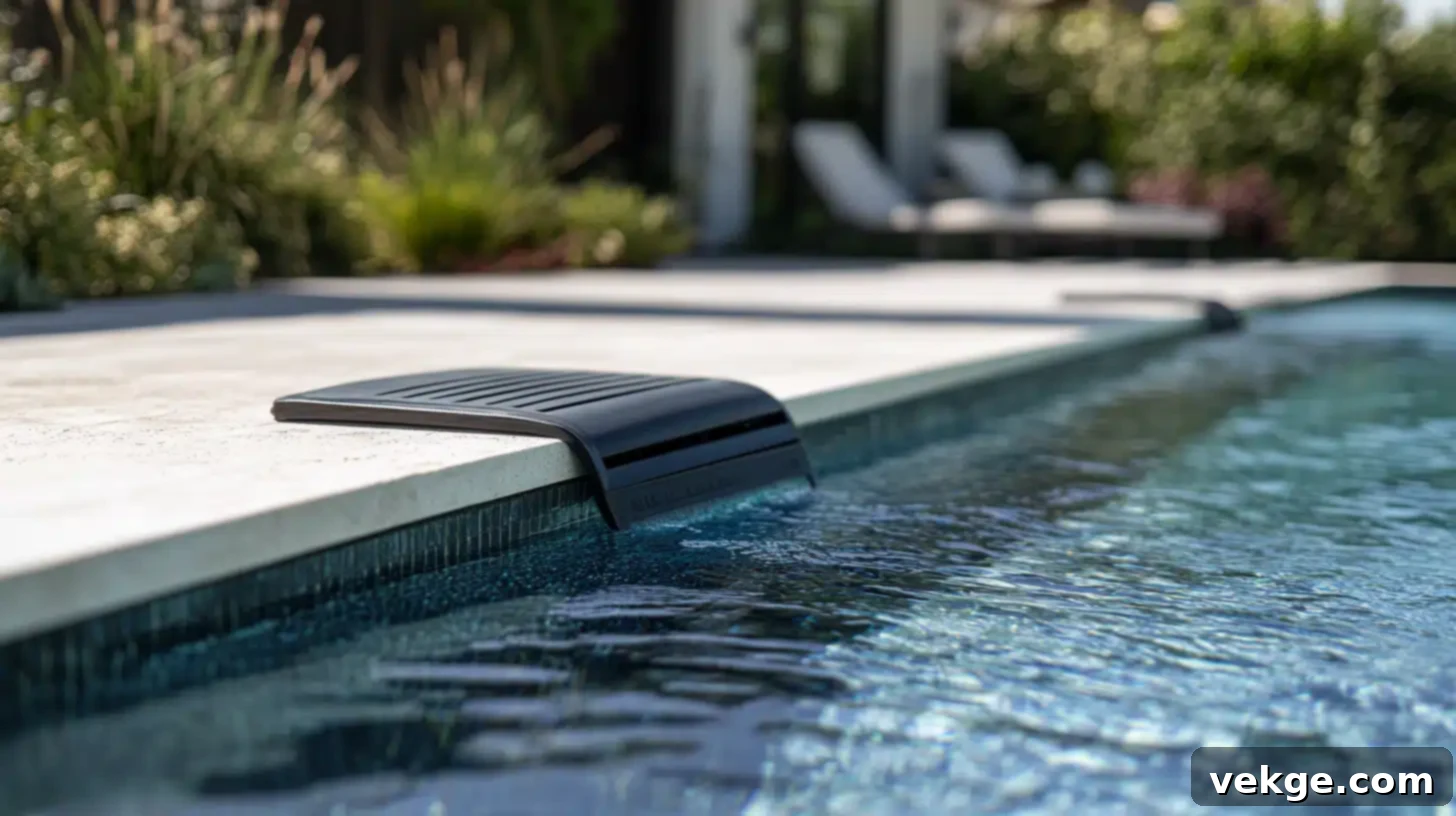The Essential Guide to Pool Skimmers: Unlocking Crystal Clear Water and Effortless Maintenance
Owning a swimming pool offers a personal oasis of relaxation, fun, and escape, providing endless joy for families and friends. However, this luxury also comes with the significant responsibility of ensuring its cleanliness, safety, and operational efficiency. A truly inviting pool isn’t just about sparkling, debris-free water; it’s fundamental for safeguarding the health of swimmers, extending the lifespan of your pool’s infrastructure, and maintaining balanced water chemistry. Amidst the various tools and processes involved in comprehensive pool care, one often-underestimated hero stands out: the pool skimmer. This indispensable component plays a truly crucial role, serving as your pool’s first line of defense against surface contaminants, ensuring your aquatic haven remains pristine and inviting.
This comprehensive guide will delve deep into the world of pool skimmers. We’ll explore what they are, why they are so critically important, the diverse types available to suit various pool setups, and how to effectively maintain them for peak performance. By the time you reach the end of this guide, you will possess a thorough understanding of how pool skimmers operate, their profound impact on pool hygiene, and why they are an absolutely vital asset for every dedicated pool owner seeking crystal clear water with minimal effort.
What Is a Pool Skimmer and How Does It Work?

At its core, a pool skimmer is a strategic component of your pool’s overall filtration system, ingeniously designed to efficiently capture debris floating on the water’s surface before it has the opportunity to sink to the bottom. This proactive approach is essential, as it not only significantly contributes to maintaining the pool’s visual appeal and cleanliness but also prevents larger, more problematic debris from clogging the intricate components of your pool’s vital filtration system, such as the pump impeller or filter media.
Typically, a built-in skimmer manifests as a robust, rectangular opening meticulously integrated into the side wall of the pool, usually positioned near the water’s surface. This opening serves as the gateway through which water is drawn, effectively pulling in leaves, insects, pollen, and other unwanted particles that accumulate on the surface. Inside this opening, a clever system of components works in harmony: a hinged flap known as a weir allows debris to enter but prevents it from easily floating back out, directing it into a waiting skimmer basket. From there, a powerful suction line connected to your pool pump draws the skimmed water towards the main filtration system, leaving the trapped debris safely contained within the basket.
Regular and diligent maintenance of your pool skimmer, particularly the routine cleaning of its basket, is absolutely paramount. This critical task ensures optimal performance, prevents clogs, and significantly prolongs the life of your entire fibreglass pool equipment, protecting your investment and guaranteeing a consistently clean swimming environment.
Key Components of a Pool Skimmer Explained
Understanding each part of your skimmer helps in troubleshooting and maintenance:
- Skimmer Opening (Skimmer Throat): This is the large, visible rectangular opening positioned at the water line, acting as the entry point for both water and floating debris. Its strategic placement allows it to draw in surface water where most contaminants reside due to surface tension.
- Skimmer Weir (Flap Gate): Often overlooked, this small, hinged flap inside the skimmer opening is crucial. It oscillates with the water’s movement, allowing debris to easily enter the skimmer but preventing it from escaping back into the pool, especially when the pump is off or there’s wave action. It also helps to ensure maximum surface skimming by concentrating the water flow.
- Skimmer Basket: Situated directly below the weir, this removable basket is the primary collection point for larger debris such as leaves, bugs, twigs, and hair. Its fine mesh design prevents these items from reaching the more sensitive and expensive components of the pool pump and filter, thereby protecting them from potential damage and blockages.
- Suction Line: This plumbing line connects the bottom of the skimmer well to the pool pump. It’s responsible for pulling water through the skimmer, creating the necessary suction to draw in surface debris and direct the filtered water towards the main filtration system for further cleaning before returning it to the pool.
- Skimmer Lid (Deck Lid): While not directly involved in skimming, the skimmer lid covers the top opening of the skimmer, providing easy access to the skimmer basket for cleaning. It also serves as a safety feature, preventing accidental falls into the skimmer well, and keeps unwanted elements out.
By efficiently handling surface contaminants, skimmers dramatically reduce the likelihood of clogs within the broader filtration system, ensuring smooth, uninterrupted water circulation and significantly decreasing the frequency and intensity of manual pool cleaning tasks.
The Indispensable Role of Pool Skimmers in Maintaining a Pristine Pool

Pool skimmers aren’t just a convenience; they are your pool’s absolute first line of defense against floating debris and a cornerstone of effective water quality management. They work tirelessly and continuously to remove contaminants from the water, thereby enhancing both overall cleanliness and the crucial health of your swimming environment. Let’s explore their multi-faceted benefits in detail.
Efficient Debris Removal and Prevention of Stains
Skimmers excel at trapping a wide array of surface debris, including leaves, insects, pollen, hair, and small twigs, often before these elements have a chance to become waterlogged and sink to the bottom. This proactive removal is vital because once organic debris sinks, it begins to decompose, releasing nutrients that can fuel algae growth and potentially causing unsightly stains on your pool’s plaster or liner. By capturing debris early, skimmers drastically reduce the need for constant manual vacuuming and brushing, saving you considerable time and effort in your pool maintenance routine.
Improved Water Circulation and Chemical Distribution
Effective surface skimming plays a critical role in enhancing overall water circulation throughout your pool. By drawing water from the surface, skimmers help ensure that all parts of the pool, especially the top layer where most contamination occurs, are continuously circulated through the filtration system. Good circulation is absolutely vital for evenly distributing pool chemicals, such as chlorine and algaecides. This even distribution prevents “dead spots” where chemicals might not reach, effectively inhibiting algae growth and maintaining a balanced water chemistry, which is key to a healthy and inviting pool.
Reducing Filter Load and Extending Equipment Lifespan
By efficiently capturing the majority of large debris before it can enter the main plumbing lines, skimmers significantly reduce the workload on your pool’s primary filter and pump. This pre-filtration step means less strain on the pump motor, fewer backwashes or cartridge cleanings for your filter, and ultimately, a longer operational life for these expensive pieces of equipment. A well-functioning skimmer translates directly into reduced energy consumption, lower maintenance costs, and fewer expensive repairs or replacements over time, offering substantial long-term savings for pool owners.
Enhanced Swimmer Comfort and Safety
Beyond the practical benefits, a clean pool surface directly contributes to a more enjoyable and safer swimming experience. No one wants to swim through a layer of leaves or dead insects. Skimmers ensure that the water you’re swimming in is free from visible floating contaminants, making the pool far more aesthetically pleasing and hygienic. Furthermore, removing sharp debris like twigs or even errant toys before they sink can prevent potential cuts or injuries, enhancing the overall safety for everyone enjoying your pool.
Types of Pool Skimmers: Finding the Perfect Fit for Your Pool
The world of pool skimmers isn’t one-size-fits-all. There are several distinct types, each designed to cater to different pool constructions, operational needs, and maintenance preferences. Understanding these variations will empower you to choose the most effective skimming solution for your specific pool setup.
Built-In Skimmers
Built-in skimmers are the most common type found in inground pools. These are permanent fixtures, seamlessly and discreetly integrated into the pool structure itself during the initial construction phase. Their design prioritizes maximum efficiency, strategically placed at the ideal water level to consistently capture surface contaminants and debris as water is drawn into the filtration system.
- Design & Integration: They feature a throat that opens directly into the pool wall, typically leading to a deep well housing the skimmer basket. A convenient lid, usually flush with the pool deck or coping, provides easy access for routine basket emptying and inspection.
- Efficiency: Known for their superior performance due to their fixed, optimal positioning and powerful suction linked to the main pool pump.
- Maintenance: Requires regular emptying of the basket, typically accessed via the deck lid.
- Ideal For: Virtually all inground concrete, fiberglass, and vinyl liner pools.
Floating Skimmers
Floating skimmers offer a versatile and often portable solution, making them particularly ideal for above-ground pools or as supplementary skimmers for inground pools. Unlike their built-in counterparts, these devices gracefully glide across the water’s surface, autonomously capturing debris like leaves, pollen, and dirt. Many floating skimmers also contribute to better overall water circulation by creating localized currents.
- Installation: Their key advantage is exceptionally easy installation—often requiring no professional help, simply plugging them into an existing pump outlet or operating independently.
- Mobility & Coverage: As they float, they can cover a wider area of the pool surface, effectively targeting debris wherever it congregates.
- Versatility: They can function as a primary skimmer for pools without built-in options or work alongside existing built-in skimmers for enhanced skimming efficiency, especially in pools prone to heavy debris.
- Power Source: Can be powered by the pool’s existing pump (sucking directly into a skimmer outlet) or have their own internal pump.
- Ideal For: Above-ground pools, smaller inground pools as a supplement, or temporary pool setups.
Manual Skimmers
Manual skimmers are the most fundamental and universally recognized pool cleaning tool: a simple handheld net attached to a telescopic pole. While they may not offer the continuous, automated efficiency of built-in or floating skimmers, they are absolutely invaluable for quick, targeted clean-ups and essential for every pool owner’s toolkit.
- Functionality: They allow pool owners to quickly and precisely remove floating debris from the surface, reaching areas that automatic skimmers might miss or for immediate post-storm clean-ups.
- Versatility: Highly versatile and useful for pools of all sizes and types, especially for smaller pools or addressing specific problem areas with heavy debris accumulation.
- Cost-Effective: They are the most affordable type of skimmer and require no power source or complex installation.
- Essential Supplement: Even with automatic skimmers, a manual skimmer is crucial for scooping out larger items, cleaning corners, and performing immediate spot removal.
- Ideal For: All pool types as a complementary tool, quick clean-ups, and reaching specific areas.
Mastering Regular Skimmer Maintenance for Optimal Performance and Longevity
Maintaining your pool skimmer isn’t just about cleanliness; it’s a critical aspect of ensuring your entire pool system functions effectively, efficiently, and for years to come. Neglecting skimmer maintenance can lead to a cascade of problems, from poor water quality to costly equipment damage. Here are comprehensive tips to keep your skimmer in top shape.
1. Regular Basket Cleaning: The Golden Rule
It is absolutely essential to empty the skimmer basket regularly. For most pools, this means at least once a week, but during seasons of heavy debris (e.g., autumn with falling leaves, after strong winds), daily cleaning might be necessary. A full or clogged basket severely restricts water flow, significantly reducing suction efficiency and putting undue strain on your pool pump. To clean:
- Turn off the pool pump: This is a crucial safety step to prevent injury from the powerful suction.
- Remove the skimmer lid: Carefully lift the lid, usually located at deck level.
- Pull out the basket: Gently retrieve the basket, taking care not to let trapped debris fall back into the skimmer well.
- Empty and rinse: Dispose of the debris and thoroughly rinse the basket with a garden hose to remove any fine particles or slime.
- Check the weir: While the basket is out, quickly check for and remove any debris that may be caught in the skimmer weir or throat. This buildup can impede its movement and reduce skimming effectiveness.
- Replace: Place the clean basket back into the skimmer well, ensuring it’s seated correctly, and securely replace the skimmer lid.
Regular basket cleaning not only enhances the skimmer’s performance but also prevents more significant issues like clogged suction lines or damaged pump impellers.
2. Inspect for Damage and Wear
Periodically, perhaps once a month or during your weekly cleaning routine, conduct a thorough inspection of all your skimmer’s components. Look for any signs of wear and tear, which can compromise functionality:
- Skimmer Basket: Check for cracks or holes. A damaged basket can allow debris to bypass it and reach the pump.
- Weir Flap: Ensure the flap moves freely and is not cracked, broken, or dislodged from its hinges. A damaged weir can prevent efficient debris capture.
- Skimmer Body: Inspect the interior of the skimmer well for cracks or leaks, which could indicate structural issues and lead to water loss or compromised suction.
- Suction Line: Listen for any unusual noises from the pump or observe weak suction, which could indicate an air leak in the suction line leading from the skimmer.
If you notice any damaged parts, it is crucial to replace them promptly. Ignoring minor damage can quickly lead to more significant problems, compromising the skimmer’s efficiency and potentially affecting the overall health and safety of your pool.
3. Seasonal Maintenance and Winterization
The changing seasons bring specific skimmer maintenance needs. Performing thorough checks before and after the swimming season is vital for prolonged optimal performance:
- Pre-Season (Opening): Before you open your pool for the swimming season, perform a deep clean of the skimmer. Remove any accumulated debris from the off-season. Ensure the weir flap is moving freely and lubricate any moving parts if necessary. Check all seals and gaskets for leaks. Ensure the skimmer is properly secured and aligned.
- Post-Season (Closing/Winterization): For pools in colder climates, proper skimmer winterization is critical to prevent freeze damage. This typically involves removing the skimmer basket and weir, draining the skimmer well, and plugging the skimmer lines to prevent water from entering and freezing. Following proper winterization procedures is paramount to protect your skimmer from costly damage.
Taking these seasonal steps will help maintain optimal skimmer performance throughout the swimming season and prepare it effectively for the off-season, extending its lifespan considerably.
4. Troubleshooting Common Skimmer Issues
Even with regular maintenance, skimmers can sometimes encounter problems. Here are quick tips for common issues:
- Weak Suction: First, check the skimmer basket for clogs. Then, inspect the weir for obstructions. If suction is still weak, check the pump basket for debris, and ensure the water level in the pool is adequate (mid-skimmer opening is ideal). Air leaks in the suction line can also cause weak suction, often indicated by air bubbles in the return jets.
- Broken Weir: A broken weir means debris can easily escape back into the pool. This is a common part that can be easily replaced. Simply purchase a new weir designed for your skimmer model and snap or screw it into place.
- Clogged Skimmer Line: If the skimmer basket and pump basket are clear but suction is still poor, you might have a clog in the underground skimmer line. This often requires professional assistance with specialized plumbing snakes or hydro-jetting tools.
Conclusion: Your Pool’s First Line of Defense for Enduring Beauty
In summary, the humble pool skimmer is far more than just a simple opening in your pool wall; it is an absolutely indispensable tool for maintaining a consistently clean, healthy, and efficient swimming pool. By diligently removing surface debris, significantly enhancing water circulation, proactively preventing algae growth, and dramatically reducing the workload on your pool’s entire filtration system, skimmers ensure that your aquatic sanctuary remains a constant source of joy, relaxation, and ease of maintenance.
For every pool owner, a deep understanding of your skimmer’s function and a commitment to its regular maintenance are not merely beneficial—they are crucial. Prioritizing consistent upkeep will not only dramatically extend the life of your skimmer itself but will also contribute immensely to the overall health, longevity, and pristine condition of your entire pool. Think of your skimmer as the vigilant guardian of your pool’s surface, constantly working to preserve its beauty and functionality.
If you’re looking to truly elevate your pool maintenance routine and ensure consistently sparkling water, make skimmer care a cornerstone of your regimen. Invest in understanding its components, commit to regular cleaning, and address any issues promptly. These simple yet powerful steps will guarantee that your pool remains an inviting and immaculate retreat for years to come. Happy swimming, and enjoy the effortless beauty of a perfectly skimmed pool!
